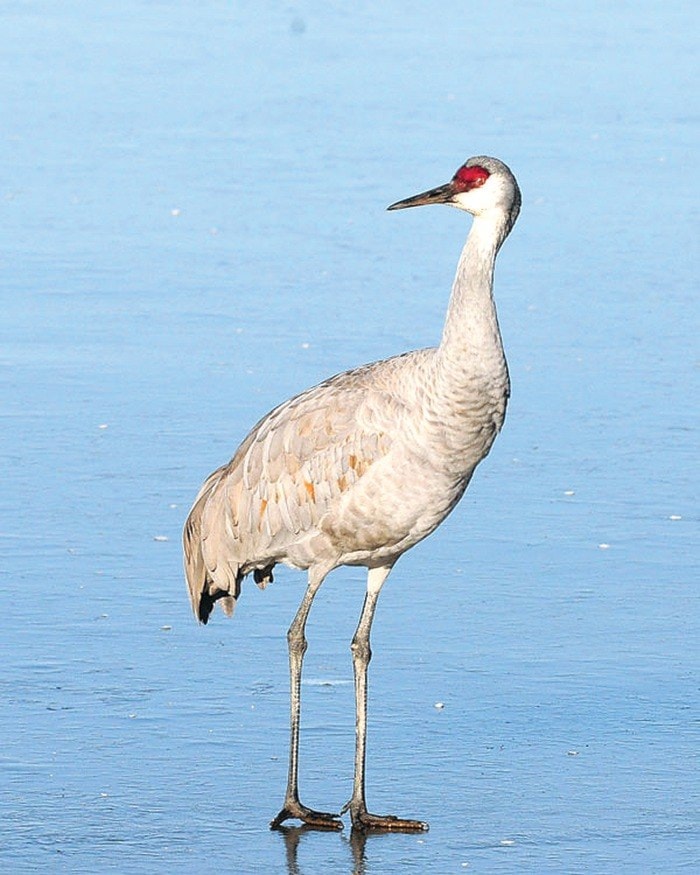The oldest living bird species just happens to live in British Columbia.
Wing fossils of the sandhill crane found in Nebraska date back nine million years to the Miocene era, and they certainly still have a prehistoric look about them.
These cranes have overcome many obstacles over this time adapting to an ever changing environment. There are six species of sandhill cranes and by far the largest populations congregate in Nebraska along the Platte River.
Sandhill cranes can attribute their longevity to their highly complex social behaviour, long-term care of their young and an innate wariness. They are known to live on average between 25-30 years.
Found in many parts of the world, the North American populations cover most of the continent. Populations in British Columbia tend to be centered in the Fraser Valley, western Okanagan, and the southern Rocky Mountain Trench.
The Comox Valley area is not a usual pit stop for migratory cranes but each year they pass overhead in flocks. They are known to land in the Nanaimo area but the largest flocks can be found in Delta at the Reifel Bird Sanctuary.
Sandhill cranes migrate to the Baja Peninsula in California and also further south into Mexico. There are also year round residents that do not migrate. Remarkably, cranes can travel between 200-300 miles per day and have been known to travel up to 500 miles with favourable tail winds.
Resembling great blue herons in size and stature, they are very different in many other ways. Standing 3-4 feet tall, they have a huge 6-7 foot wingspan. Their overall body coloration is grey with rusty tints, these tints are even more pronounced prior to their fall molt as they preen their feathers with iron rich mud.
The most distinct adult feature is their crimson forehead and white cheeks. They also have long pointed beaks that have serrated edges and are designed to probe even if the soil is frozen.
Long, dark-grey legs have splayed feet equipped with claws which they use to defend themselves by jumping and striking out like a kick-boxer.
Although in flight they are very elegant – holding their neck and feet outstretched – they are less elegant when they land. Simulating a parachute, they drop to the ground with half open wings and spread their short tail feathers that resemble a” Victorian bustle” to slow them down.
Habitat for sandhill cranes includes freshwater wetlands, bogs, sedge meadows and open grasslands. They also delight in devouring freshly planted crops like alfalfa. Staple foods for these cranes include plant tubers, grains, small mice and snakes, insects and worms.
Sandhill cranes mate for life and have spectacular courtship rituals, they dance and prance, leap into the air tossing sticks or clumps of grass vocalizing at the same time with rattling calls and throaty croaks.
In ten years at Mountainaire Avian Rescue Society (MARS) I have only encountered one crane that was very memorable. Last week, a single bird was reported to have grounded in Merville. It appeared that the bird was left behind when the flock continued its southern migration.
It sought out company at a Muscovy duck farm. The ducks were in an enclosure and the crane was pacing along the fence line maybe hoping to join them.
Having determined that the crane could fly and was foraging and not in any distress the decision was made to try and catch and relocate the crane with a flock.
When I heard about the crane and its relocation, I immediately thought of Mike Yip who is always out and about photographing wildlife and I had seen recent sandhill crane photos on his web site. Mike confirmed the sandhill cranes were still at the Reifel Bird sanctuary in Delta and offered to transport the crane once it was caught.
Capturing the bird was very easy with the help of a new remotely triggered “bow net” (donated by the Hornby Eagles Project Society). The capture of the bird created quite a stir with biologists from the Canadian Wildlife Service and The Hemmera Corporation, who were informed that the bird was coming to the Reifel Sanctuary. They conducted blood and feather samples to help determine the sub species which identified it as a lesser sandhill crane.
The bird was then banded with a federal band and also bright orange and yellow bands on the other leg in hopes that birders will be alerted to record its location. It had been hoped to mount a satellite tracking transmitter on the crane but permits could not be obtained in time. Data collected will be invaluable for further understanding, distribution, migration, and taxonomy of the cranes so far only one other B.C. bird and seven from Alaska have been banded.
If you wish to find out more please consider a trip to Delta and experience the truly amazing phenomenon of migration. Thanks to Mike Yip and all the volunteers who were part of the sandhill cranes migratory dilemma.
To report injured wildlife or for advice call 1-800-304-9968.
www.wingtips.org
